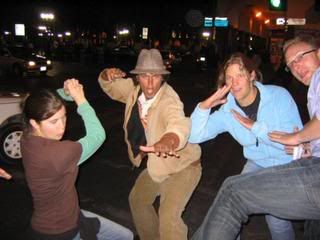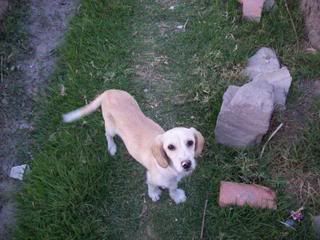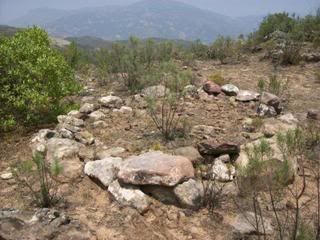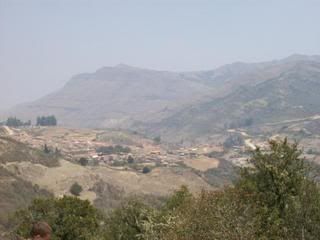Anyway, I have some pictures to share that backtrack a lot, so… This first one is of Chris, Alex, Colin, and me in D.C. doing some site seeing during staging.

The next three are of our first welcome activity in Cochabamba, a scavenger hunt. There’s me high-fiving a cop, everyone attempting to spell out CORREO in front of the post office, and my group as ninjas.



These are some pictures from the little pueblo we lived in during training. The view of Cochabamba is spectacular. You can just barely see the little white Christo in the picture, but trust me that the actual view is much cooler. The last picture is of my host family’s puppy, Perla. Everyone seemed to hate this dog except me. She reminded me of Princess when she was a puppy- so energetic and playful.



This is Tarata, where we went for technical weekend. I was sick, so I dont really have much more to say about tech weekend, sorry

So, we set up a booth at this tourism fair in Cochabamba. While I have no pictures of the actual booth (which would have been cool) to show you, I have this nice picture of me brushing my teeth downtown. Enjoy.

Now, onto the good stuff. So, technical week was arguably the highlight of our training experience. During technical week, we get to travel to a few volunteer sites to see what Peace Corps Bolivia is all about. We see their houses, stay in hotels in the town, and do some work with the people in the towns. We visited three sites; Semaipata, Pucara, and Vallegrande. All of the places we are visited are in the department of Santa Cruz, which is the easternmost department in Bolivia. It’s known for hot weather and jungles. However, we visited towns that aren’t that far east into Santa Cruz, so of the weather wasn’t particularly hot. As we drove to Semaipata (more or less a ten hour drive), it was really interesting to see the landscape change. The hills/mountains in Cochabamba are all very dry and brown right now. A little bit further east, the hills are just covered in fields. It really amazes me that people can farm on that kind of land, and it’s just awesome to see. I don’t know if you can see all of the little plots in the pictures, but it was really neat.


When you go east towards Santa Cruz, though, the climate gets more tropical and the hills are covered in trees. There are a lot more eucalyptus trees and some shorter trees, kind of like the ones you typically think of seeing in Africa. In Semaipata, we were basically just tourists for a day and a half, seeing the town and the nearby waterfalls. The idea behind being tourists was to do a diagnostic/analyze the tourism in Semaipata. To me, Semaipata is an interesting/sad place because, while it has some level of developed tourism, it is mostly run by the Dutch, not Bolivians. The waterfalls/park was really beautiful and relaxing. Plus, it was cool to be in a tropical setting. I’m for sure going to have to vacation at least once in Santa Cruz.


The subject of tourism in Peace Corps Bolivia is interesting and fairly new. Training stresses community tourism, which involves all levels of community members with the idea that the benefits would more evenly reach all levels of the community and the level of which is more suitable for developing towns. Involving the entire community has added benefits because the more the community invests in a project, the more likely it is to be sustainable. Also, the idea is that many of the things that are beneficial to a developing town (infrastructure, better business practices, sanitation, etc.) are necessary for tourism, so the means of development for the two go hand-in-hand. I think the success of such a project depends very much on the site you go to, the time spent there, and the ways in which you go about development. Some sites may very well be ready to implement a responsible, sustainable community tourism plan and others not. It will be interesting to see how this goes.
The second town we visited was Pucara, a small site where a volunteer is about to finish her service. We split up into groups to help some high schoolers put up signs on a hiking trail that led to Incan ruins. I made friends with the cutest little girl and we had a really nice three hour hike. It felt really good to get some exercise and sunshine. It’s difficult for me to feel reassured that what we did that day was sustainable in and of itself, but I think the work, particularly the education part, that the volunteer did there in two years, certainly had a greater impact on the town.




Before leaving Pucara, we took a very short trip to La Higuera. There was a big Che fest in Vallegrande and La Higuera. La Higuera is the community (I’m not sure it’s really big enough to be called a town) where Che Guevara was captured and killed. There’s hardly anything to do there, but there is this giant bust of Che.

In Vallegrande, we taught classes (in groups of 2-3 trainees) about basic business concepts and lead them through a business simulation in which they made and sold their own products in groups. I was both surprised by the education system here and very proud of our students, two groups of which had a dance (so creative!) and we all went. I enjoyed teaching and really felt like we increased their awareness of some basic business skills. The business sim was the most challenging and my favorite activity thus far.

During technical week, our APCD had his final meeting with me about my site. For safety reasons, I’m just going to say that I am going to be in the department of Oruro, which is part of the Bolivian Altiplano, or highlands. If you’d like to know my exact site, feel free to email me, but I’d like it to remain fairly private information. However, I’d be more happy tell you some more about Oruro and the Altiplano in general. (Sidenote: the information provided here is more or less a summary of a general informational Altiplano handout provided to me by the PC. The information here reflects neither my own personal opinions nor those of the Peace Corps. As with anywhere, everyone’s individual experience in the Altiplano will be different.) The work in my site is pretty open-ended and i’ll be the first Microenterprise (MED)/Tourism/ICT volunteer there. That means that my community diagnostic (a three-month process where we basically do a bunch of investigative work, etc. to get to know the community, to assess its needs, and to start to integrate) is going to have to be really thorough, but that the work itself will be pretty flexible based on my interests and the needs of the community. Basically, I’m going to have a multitude of work opportunities at my fingertips and It’s all going to be very beginning level and open-ended. I think the elevation in Oruro is around 12,000 ft, but you might want to check on that because that number is supposedly the average of all of the altiplano, which includes three departments, Oruro, La Paz, and Potosi. The Altiplano is flat and bare, but is surrounded by mountains (duh) as well as having some lakes, mines, the salt flats, and llamas! I don’t know exactly what to expect, since I’ve never been or lived anywhere like that, but I’m excited to find out. I hear there is sun almost everyday, even though it can get pretty cold. The rainiest/warmest months are December to February, although overall the climate is very dry. The main crops of the Altiplano are potatoes, chuños (which I guess are really just potatoes) rice, and other grains, but there is a wide variety of foods available in the city. The altiplano in general is the area of Bolivia with the most indigenous people and the most poverty, although I don’t know how this will be reflected specifically in Oruro or in my site. Also, Bolivia’s current President, Evo Morales, is from a town in Oruro. From what I’ve heard, Oruro is very culturally rich and the people are fantastic. The Altiplano life is said to be very tranquilo, which will be an interesting change. Finally, Orureños are also supposedly extremely politically active. I can’t wait to get to know my new home!
After technical week, we had an official site announcement party so everyone could officially know their sites. Que lujoso, no?

Also, we had a picnic to say thank-you to our host families. Among the highlights of the festivities, there was live music via PC staff, an electric slide performance via our group, and a cueca (Bolivian dance) contest. I borrowed my host grandpa's hat and jacket and my partner, Joy, and I won a three-way tie for first! Joy and I with our language teacher, Maritza.


In other news...after site visit Im going back to Marquina to get the kitten my family gave me! Hes so cute, although for now he remains unnamed. Hes the white one...


Thats all for now. I hope you are all doing well. I miss you!
-sarita




